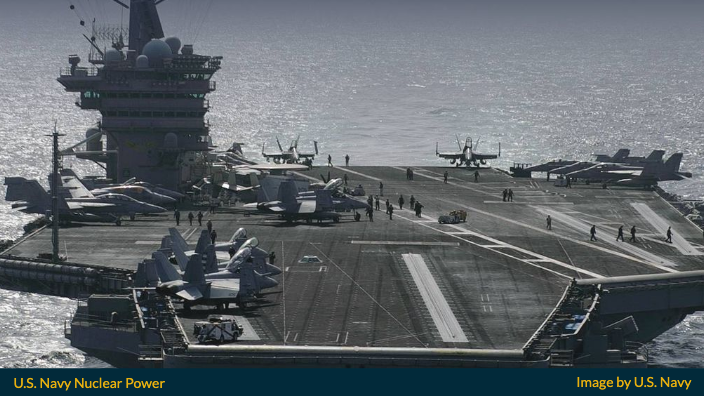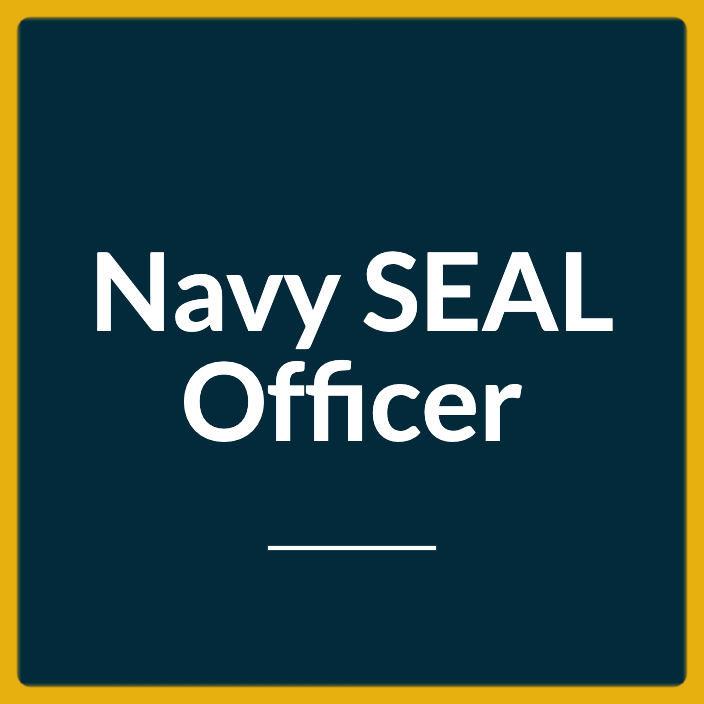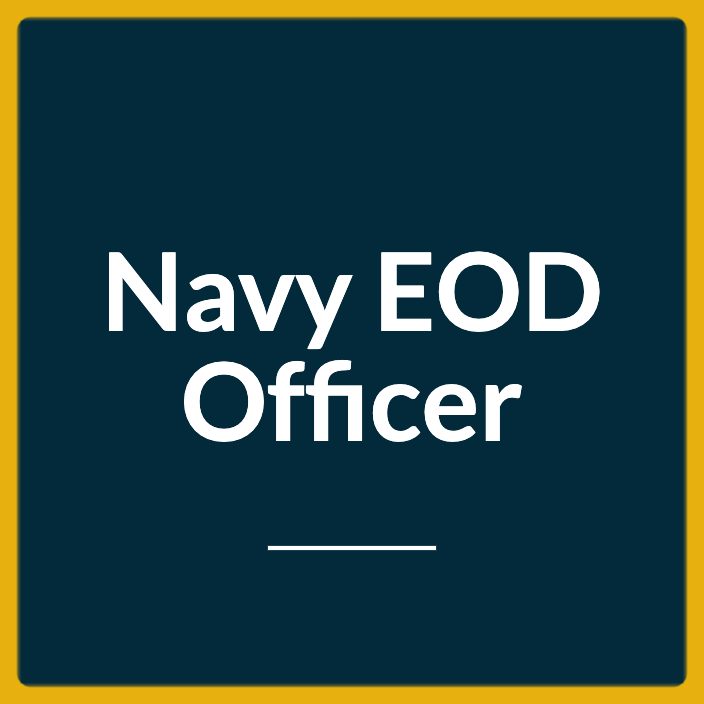Last Updated on March 4, 2024
This guide provides helpful information for those looking to become a Nuclear Surface Warfare Officer (SWO-Nuclear) during Fiscal Year 2024.
Are you prepared to lead a talented team in the world’s most technologically advanced warships?
As a Nuclear Surface Warfare Officer, you can become a technical leader with a unique specialization in nuclear power.
Aircraft carriers are at the center of our national security policy because of their ability to convey naval power to any location in the world.
Nuclear Surface Warfare Officers are Unrestricted Line Officers in the Navy who are mainly responsible for ensuring that Sailors in the Reactor Department maintain and operate the ship’s complex reactor and power generation systems in a safe and effective manner.
Do you think you have what it takes to be a leader in this capacity?
What Do Nuclear Surface Warfare Officers Do?
Nuclear Surface Warfare Officers are the backbone of fleet leadership.
Before being assigned to an aircraft carrier, you will join the conventional surface fleet.
While assigned there, you will perform missions critical to national security while leading talented and motivated Navy Sailors.
You will be required to complete your initial qualifications while assigned to the surface fleet.
After this rotation, you will eventually be assigned to a nuclear-powered aircraft carrier.
Your responsibilities as a Nuclear Surface Warfare Officer might include the following:
- Directing personnel operations on Navy ships, notably aircraft carriers
- Managing naval weapons and defensive systems, including vertical launch systems
- Using high-tech weapons and advanced technologies in warfare and ship defense
- Supporting Navy expeditionary troops, Theater Missile Defense activities, anti-submarine warfare, surface-to-air combat, and support and supply missions
Nuclear Surface Warfare Officers work in a variety of situations, including academic settings, training aboard prototype units, naval tours, and shore postings.
Deployments of many months aboard conventional ships and nuclear-powered aircraft carriers are common.
In addition to time spent operating nuclear reactors on aircraft carriers, fully certified members may go on to perform roles that involve training, advising, consulting, recruiting, or commanding surface ships.
Nuclear Surface Warfare Officer Training
Officer Candidate School
After college, the formal training procedure for becoming an officer in the Naval Nuclear Propulsion program begins.
The initial stage for anyone interested in becoming a Nuclear Surface Warfare Officer is Officer Candidate School (OCS) at Newport, RI.
Over the course of three months, Navy OCS gives a comprehensive and intensive introduction to the responsibilities of Navy Officers.
Division Officer Tour (Conventional)
Following Navy OCS, newly commissioned Ensigns spend their first sea tour as a Division Officer aboard a conventional ship, commanding a crew of Sailors in charge of everything from electronics to weaponry to ship operations.
On a tour of about 24 months, officers train for their Surface Warfare Officer certification.
Naval Nuclear Power School
Officers will attend Naval Nuclear Power School (NNPS) in Charleston, SC after their first naval assignment.
This 24-week graduate-level intense study course covers a wide range of scientific and technology topics, including mathematics, thermodynamics, electrical engineering, and reactor dynamics.
The NNPS teaches the fundamental knowledge required for a theoretical understanding of nuclear propulsion.
Nuclear Power Training Unit
The Nuclear Power Training Unit (NPTU), often known as Prototype, is located at either Charleston, SC or Ballston Spa, NY.
This 26-week program includes hands-on training with various functioning reactor prototypes.
Officers utilize what they learned at Nuclear Power School here, learning the systems and components of a nuclear propulsion plant and working with all of the associated systems of a full-scale operational plant.
The program ends in certification as an Engineering Officer of the Watch.
Division Officer Tour (Nuclear)
Following nuclear power training, officers are stationed as Division Officers to a nuclear-powered aircraft carrier’s reactor plant for roughly 28 months.
Nuclear Surface Warfare Officers complete Prospective Nuclear Engineer Officer (PNEO) training and qualification during this assignment, which is a Department of Energy accreditation recognized by the civilian nuclear power sector.
Post-Training Career Opportunities
Surface Warfare Officers can work anywhere from Nuclear Power School and Prototype to other occupations ashore after finishing their maritime deployments.
They may be chosen to serve on high-level staff, work on critical projects, or pursue their education by taking advantage of the Navy’s numerous graduate school possibilities.
For many Nuke and conventional SWOs, the ultimate ambition is to one day command their own surface ship.
Post-Service Career Opportunities
A career as a Nuclear Surface Warfare Officer will provide you with excellent post-service opportunities.
Because of the program’s extremely selective structure, paired with world-class advanced training and credentials, your skills and expertise are in great demand.
Adding “Navy Nuke” to your resume will position you as a top contender for a range of potential occupations, including civilian engineering and management positions after you conclude your commitment.
Educational Opportunities
In addition to best-in-class training and cutting-edge facilities, current undergrad students who match the required background will have the opportunity to earn money while finishing school through the Nuclear Propulsion Officer Candidate (NUPOC) program.
Students majoring in mathematics, engineering, physics, and chemistry may be given priority admission to the NUPOC program.
If you are accepted into the NUPOC program as an aspiring Nuclear Surface Warfare Officer, you will get the following:
- Earn more than $4,000 per month for up to 30 months even before graduating college.
- Receive a one-time $15,000 sign-on bonus. Plus, you will receive an additional $2,000 incentive when you finish nuclear propulsion training.
- Enjoy military health-care benefits while enrolled in the program.
- Use your college years while enrolled in the program to count toward your retirement.
- While in college, you will be considered to be a full-time student with no military commitments or duties.
Interested applicants may contact a Navy Recruiter and inquire about participating in a relevant question and answer information seminar. This will allow you to learn more about the position and get answers to any questions you may have.
Applicants are not required to join the program when they attend these weekly seminars.
Postgraduate Educational Opportunities
When you finish school, you will be able to apply for a career as a respected professional and officer in the world’s most accomplished nuclear program.
In addition to your undergraduate and official Navy training and education, you can further your education by:
- Completing the Joint Professional Military Education (JPME) at one of the various service colleges
- Using Tuition Assistance benefit to attend online or in-person graduate programs during shore assignments
- Navy College Program
- VOLED Assistance Center
- VOLED Region Advisors
- The Naval Postgraduate School (NPS)
- Navy War College (NWC)
- US Air Force Air University Air Command and Staff College
Nuclear Surface Warfare Officer Challenge

A nuclear-powered aircraft carrier is equipped with two nuclear reactors, 85 aircraft, 5,500 crew personnel, and endless potential.
Imagine yourself in charge of a 97,000-ton nuclear-powered aircraft carrier of the Nimitz class.
Your mission is to travel throughout the world to support American interests and commitments.
While your civilian peers may still fantasize about managing a small technical team, you will be in charge of a virtual metropolis at sea, overseeing the operation and maintenance of extremely complex nuclear propulsion plants.
Are you up for this kind of challenge?
If so, keep reading for information on how to get started.
How To Become A Nuclear Surface Warfare Officer
Because of the difficult nature of the Naval Nuclear Propulsion Program and the enormity of the tasks members will take on from a young age, the qualifications to become a candidate and join NUPOC are strict.
Below are the basic eligibility requirements for Navy NUPOC – Nuclear Surface Warfare Officer. These requirements are current as of May 2019, per the Navy Personnel Command. No updates have been issued so far.
Basic Eligibility Requirements: Nuclear SWO
1. Gender
The NUPOC program is available to both men and women.
2. Citizenship
Nuclear SWO applicants must be a U.S. citizen (dual citizen applicants must renounce other citizenship).
3. Education
Candidates must be current students or graduates of a U.S. accredited college or university pursuing a BS, BA, or MS (preferably major in engineering, mathematics, chemistry, physics, or other technical fields – but not required).
Academic Requirements
- One academic year of calculus – Finish satisfactorily
- One academic year of calculus-based physics – Finish satisfactorily
- Competitive Cumulative Grade Point Average and a minimum grade of “C” in all technical classes
Graduates
Applicants must have completed a bachelor’s degree from an accredited college or university in the United States, while satisfying the academic requirements.
College Students
Those still in college may apply as early as 30 months from completion of an undergraduate degree for a Surface Warfare (Nuclear) position.
Postgraduate
Applicants currently enrolled in postgraduate studies may also apply for the NUPOC program as early as 12 months before graduating with a master’s degree.
4. Age
Nuclear SWO applicants must be at least 19 years old and less than 29 years old upon commissioning.
Age waivers up to 31 years old may be considered on an individual basis.
5. Physical
Nuclear SWO applicants must pass a physical and medical screening, typically conducted during the application process.
Upon Selection For Commission
If selected by the Director, Naval Reactors, applicants will attend a 1-day orientation in the Washington, DC area.
Upon completion of orientation, applicants have the following options:
- Enlist and be placed in active duty status as an officer candidate (E-6) in the Navy Reserve; or
- Enlist and be placed in an Inactive Navy Reserve status as an officer candidate (E-6) if designated as inactive prior to selection; or
- College graduates are expected to enlist and be placed in an active duty status as an officer candidate (E-6) in the Navy Reserve until completion of OCS when they will be commissioned into the Regular Navy.
Active duty and reserve members of any service selected for the NUPOC program will retain their current rank. If their current rank is below E-6, they will automatically be promoted to E-6.
All selectees placed in active duty status are entitled to full pay, benefits, and allowances – except for clothing allowance.
Service Obligation for Nuclear SWO
Selected Nuclear SWO applicants will incur a 5-year active service obligation.
The total service obligation is 8 years, 3 years of which may be served under Inactive ready Reserve status.
More Information
If you want more information about becoming a Nuclear Surface Warfare Officer, the next logical step is to contact a Naval Officer Recruiter.
Let us start figuring out how you can benefit from becoming a Nuclear Surface Warfare Officer – or if it is even the right career move for you.
You may also find more information about other closely related Navy Officer jobs in our Quick Guide for Unrestricted Line Officer programs, such as the Surface Warfare Officer program and the Nuclear Submarine Warfare Officer program.


